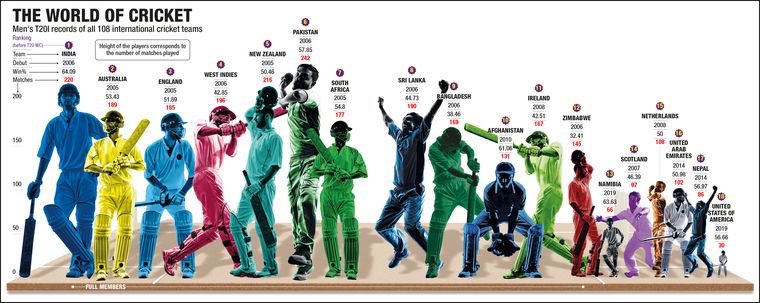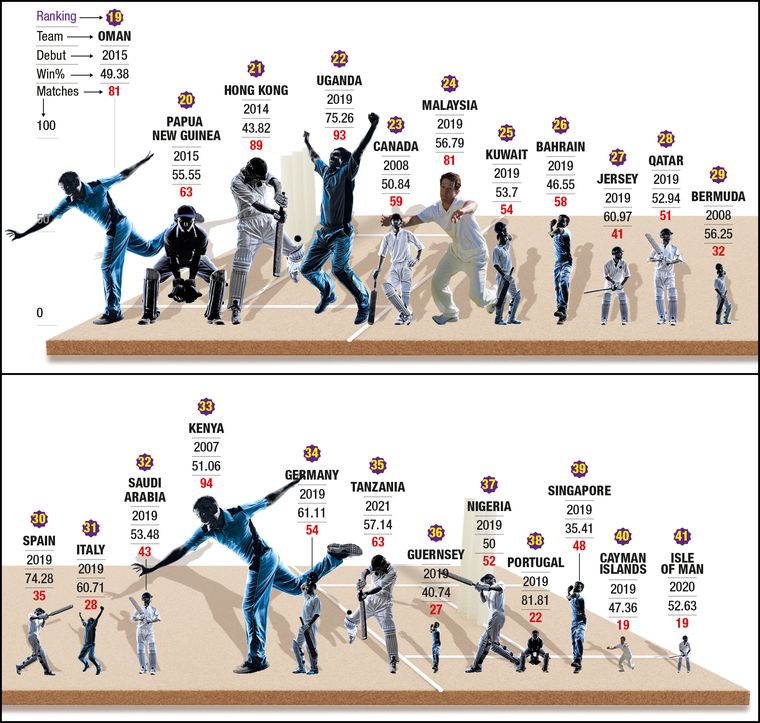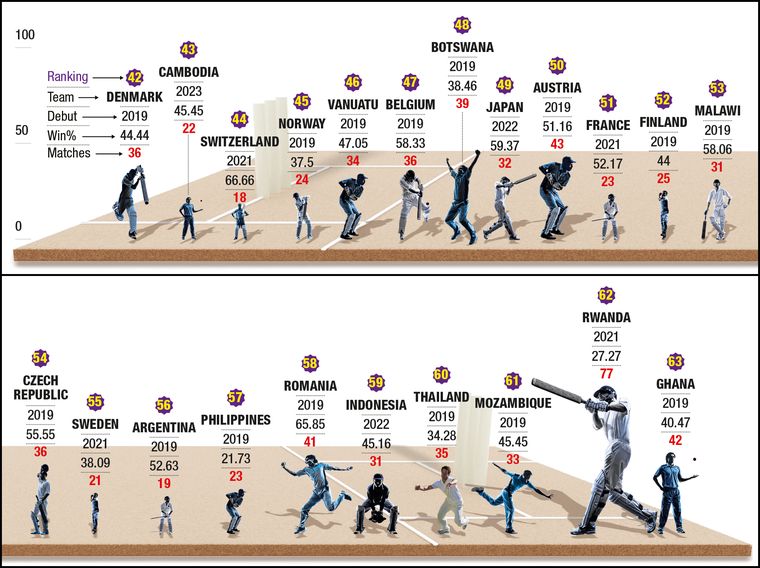Are you not entertained, America?” Nasser Hussain hollers as Aaron Jones’s 10th six sails into the night sky over suburban Dallas, giving the US a turnaround victory against Canada in the opening match of the ICC T20 World Cup at the Grand Prairie Cricket Stadium. Right there―in Nasser channelling his inner Russell Crowe, Texas sixes, floodlights, fireworks and commentators calling, “that’s a home run anywhere in America”―is the mashup that cricket, the world’s second most widely followed team sport, has sought for long.
The majority of this World Cup’s 55 matches will take place across the Caribbean. But it is the 16 games in this first fortnight on the US mainland―in suburbs and towns outside Dallas, New York and Fort Lauderdale―that are meant to be the headliners. To make a bit of noise and stir the edge of the very vast pond that is US sport.
Never mind the final in Barbados on June 29, India vs Pakistan on June 9 was the Big Show for the Big Apple. Well not exactly New York City, but certainly in New York state. On a drop-in pitch in a pop-up stadium, the Nassau County International Cricket Stadium (NCICS), in a Long Island town called East Meadow. Its temporary stands were flown in from the Las Vegas F1 Grand Prix, its tickets set at high-roller prices. What was noted in The New York Times other than the game’s “festive and vibrant atmosphere” were the possible numbers watching outside the stadium’s 34,028. NYT told its readers that viewership at the last India vs Pakistan match was 398 million “in India alone…” and then added, “this year’s Super Bowl had 123 million viewers”. Gotcha, fingers crossed. That is the ripple at the edge of the pond. Which, the ICC hopes, will spread a little wider with the invigorating performance of the US team.
This is the biggest tournament ever conducted in cricket with 20 teams from the biggest to the smallest, oldest to the newest, playing alongside each other. It has drawn diaspora communities settled in the US from many cricketing nations; India vs Pakistan was always expected to fill the NCICS, but when Sri Lanka played South Africa, 17,000 turned up. Bangladesh vs South Africa drew 25,000. In Nepal vs Netherlands, the new cricket stadium in Grand Prairie, Texas, which has called itself ‘Cricket City USA’, was packed to its 7,200 capacity.

The size of the diaspora audience that watches cricket in the US has been estimated to be between two million and three million, with wilder estimates making it tenfold. But the T20 World Cup’s frenetic US fortnight was about making itself seen and heard to the Superbowl-watchers. In real terms, for cricket’s ‘globalisation’ project, this World Cup is only the cherry or the icing on the cake. It is eyeball-grabbing, visible, shareable. The images of all 20 captains have lit up New York’s Rockefeller Center building, Yuvraj Singh as ICC event ambassador turned up for a spot on ABC’s Good Morning America breakfast show. There were five ICC fan parks set up in New York, Seattle, Grand Prairie, Seaford, NY, and Lauderhill, Florida, to relay matches live. The ICC’s commentary team hired James O’Brien aka Jomboy, YouTube baseball commentator and social media influencer, to watch and talk about cricket through mainstream American eyes. Jomboy has been fascinated by bowlers’ grips and variations of pace; West Indian Ian Bishop told him that cricket’s knuckleball was borrowed from baseball.
Taking a step back, though, cricket’s globalisation cake is made up of more than what is cooking inside this World Cup. You need to be sniffing for the whiffs. In early June, Australia’s World Cup-winning captain Pat Cummins signed a four-year deal with the San Francisco Unicorns, one of six teams in the US’s T20 franchise competition called Major League Cricket. MLC’s second season begins at the end of the World Cup. Of the six teams, three are backed by IPL teams―MI New York, LA Knight Riders and Texas Super Kings. The other three teams―the Unicorns, Seattle Orcas and Washington Freedom―have Indian-origin owners and partners, like Satya Nadella and the GMR Group. MLC is owned by a 20-strong business and tech investor group called the American Cricket Enterprises (ACE).
The advent of an independent, financially viable MLC has become the ready alternative to the organisational swamp that is US cricket administration. The latest soap opera of decades-old faction-fighting, alongside reprimands and suspensions by the ICC, features USA Cricket (formed only in 2018) losing its administrative role as host of the current T20 World Cup and having its funds frozen in October 2022.
It is now clear that the ACE and the MLC franchise owners are the movers, shakers and decision-makers in US cricket. The league was built steadily over the last six or so years, getting a group of international players over to the US to “help seed the game” in the words of their former vice president of marketing Tom Dunmore, in a 2022 interview.
Over the next decade, says Washington Freedom owner Sanjay Govil, the aim is to, “Make cricket a semi-mainstream game, like you have with rugby and lacrosse. Everybody knows rugby even though it is played at certain levels.” The goal by season 10, Govil says, is to become one of the top five sports leagues in the US behind American football, basketball, baseball and ice hockey. “We are not just building a league, we are building the sport in the US…. We, the MLC founders, the franchise owners, are totally unified in the goals we have,” he says.
One layer below the MLC, the six teams have also set up Minor League Cricket as a developmental feeder league made up of 26 teams from four regions. Govil would love to have the ICC Women’s World Cup come to the US and, by 2033, have MLC franchises own their cricket-specific stadia. The Freedom franchise is looking around the Washington Beltway area, which covers both DC, northern Virginia and Maryland.
The MLC and its opening season, the majority of its matches held in the Grand Prairie Stadium outside Dallas, was described as “the greatest experiment in pro sport” by D Magazine, a 50-year-old media organisation focused on the Dallas-Fort Worth region. Grand Prairie’s cricket stadium is remodelled from an abandoned baseball venue called the AirHogs Stadium; it was vacated when the Texas AirHogs independent baseball team shut shop in 2020.
Grand Prairie stadium is today the beating heart of US cricket. Its playing surface has settled in and the first 18-day season of MLC was declared a success. Forbes reported that 70,000 fans had turned up to watch, producing revenues of around $8 million.
The Dallas-Fort Worth area is rated the fifth-largest media market in the US, which D Magazine sports editor Mike Piellucci says is also a hard market to break into because it has, “Pretty every much sport you could hope for… every big event comes through Dallas… and there is never a shortage of things to capture people’s attention.” Dallas native Piellucci said the formula for being noticed in this area is first, “Are you a winner?” Or at the very least, “Are you consistently competitive?”, like the city’s ice-hockey team, the Dallas Stars. “What I think would help with cricket in terms of getting traction, particularly MLC, if is the Texas Super Kings start winning and start to become a really successful outfit.” The Super Kings of Chennai certainly have the formula down pat in that department, so that should not take long.
Other than as an entertainment product, what does it take for a sport to grow into the main bloodstream of a new country? On a broadcast, Jomboy said, “You need to get youth playing it,” and the time frame is about “20 years for a sport to get to a new populace”. Uganda coach and former Railways and Delhi wicketkeeper Abhay Sharma, said, “Fan following is important, but playing following is more important.” How can that following then be built? If cricket wants to take that spot behind the big three or four sports leagues, Piellucci says there need to be more competitions. Through the year, not just the six weeks in what is a quiet time on the sports calendar. “To remind people that cricket exists,” he says.
How does cricket at the LA 2028 Olympics fit into this? When cricket’s entry onto the LA 2028 programme was announced (along with lacrosse) in October 2023, Niccolo Campriani, sports director for the LA 2028, said, “The commitment to grow cricket in the US is real…”
The presence of cricket in the LA 2028 programme will generate income for the International Olympic Committee (IOC) through broadcast TV revenues from India and the rest of South Asia. Currently they are, to quote Michael Payne, the IOC’s former director of marketing and TV, “peanuts.” By Payne’s calculation, the inclusion of cricket could lead to a return of $150 million over 10 years.
This amount should find its way back in equal part to the IOC’s more than 200 member nations, which include cricket’s lesser-funded 96 Associate cricket boards. At the moment Associate nations, going by their organisational pointscore and T20I ranking, receive between $1.06 million and $5,000 a year per team (men’s or women’s) from the ICC as competition/cricket grants.
Inclusion in the Olympics also attracts greater attention and funding from national governments and national Olympic associations. Plus, member nations can receive a further slice of the IOC’s pie to the ICC as well. For Tokyo2020, for example, the IOC gave out $540 million to 31 Summer Games international sports federations.
Cricket has, Piellucci says, “structured” its entry into mainstream US consciousness very well. In the course of his examining the MLC last year, he says he found that, “People who were not involved in the league were pitting their hopes on the World Cup and the Olympics to break through… What if the United States has huge success?” The US’s victory over Pakistan “was bigger than anything that has happened domestically in cricket”, he says.
Also Read
- T20 World Cup: Afghanistan shock Australia by 21 runs in Super 8s match
- T20 World Cup: Australia crush Scotland by 5 wickets; England enter Super Eight
- T20 World Cup 2024: Cricket is not new to the US. Benjamin Franklin and Abraham Lincoln were its early fans
- T20 World Cup 2024: 'Cricket is tougher than baseball', says US cricket captain Monank Patel
- T20 World Cup: India's hopes rest not on its superstar batters but on Bumrah
- Cricket cannot be a main sport in the US, says Shane Watson
Should the US get to the Super 8 “and make some noise there,” he says, “it might grease the wheels for people to stick around and say, ‘Hey, this cricket thing, it’s interesting.’ Maybe I should watch more of that.”
Cricket, says historian Prashant Kidambi, has always been a game of empire. The English empire controlled most of the 20th century cricket on the back of its tradition, culture and mythologies. At the turn of the century, the empire moved eastwards to India, which refashioned the game through its hundreds of thousands of players and millions of viewers. The Indian Premier League has disrupted and upended the game’s economy and, along with a mushrooming of copycat leagues worldwide, promises once again to re-draw the contours of the game over the next decade.
In this tumult, going westwards―literally to the US and metaphorically in trying to expand traditional frontiers through the T20 World Cup and the Olympics―is the best step for the world game outside of ICC full-member heritage hierarchies. This is the expansion of a new outpost far from the vast expanse or notice of the unyielding Indian cricket empire. Think of it like the piggybacking seen in desi traffic. Of the two-wheeler rider holding onto the trailing rope of a large speeding lorry, using its size and speed to zoom ahead. With the understanding that the time will come to let go and switch over to the power of his own engine.





